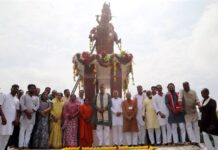We cannot allow ourselves to get side tracked in any manner from what the Kerala High Court has ruled in a most learned, laudable, landmark, logical and latest judgment titled Dr PJ Roy & Anr vs The Corporation of Kochi & Anr in WA No. 1520 of 2023 against the judgment dated 14.06.2023 in WP(C) No.10791 of 2012 of High Court of Kerala and cited in Neutral Citation No.: 2024:KER:26055 that was pronounced as recently as on April 3, 2024 wherein it minced just no words to state in no uncertain terms that no tax/penalty can be imposed under Section 242 of the Kerala Municipality Act, 1994 on a lawfully constructed building but occupied without municipality permits from the Corporation. It must be noted that the Court also made it crystal clear in this notable judgment that the construction of a building and its occupation were not the same. We thus see that the Kerala High Court allowed the appeal of the petitioner by accepting that when a building is lawfully constructed but occupied without proper permits from the Corporation, it will not attract tax or penalty under Section 242 (levying of tax on the building constructed unlawfully) of the Kerala Municipality Act of 1994. Very rightly so!
At the very outset, this brief, brilliant, bold and balanced judgment authored by Hon’ble Chief Justice Mr AJ Desai for a Division Bench of the High Court comprising of himself and Hon’ble Mr Justice VG Arun sets the ball in motion by first and foremost putting forth in para 1 that, “The question involved in this appeal is whether the owner and occupier of a building, who has constructed the building in tune with the building permit granted by the Corporation, can be made liable to pay the tax and penalty under Section 242 of the Kerala Municipality Act, 1994 (for short “Act”), on the ground that the building was occupied without obtaining the certificates mandated as per Rule 22 of the Kerala Municipality Building Rules, 1999 (for short “1999 Rules”).”
To put things in perspective, the Division Bench envisages in para 2 that, “The short facts that arise from the record are as under:
The appellants/petitioners had applied for the construction of a hospital building consisting of ground plus four floors way back in the year 2001. The plan submitted along with the application was sanctioned and the appellants issued with Ext.P1 building permit dated 25.03.2002. The appellants completed the construction of the ground floor in the year 2003 and the rest of the floors in the year 2011. Thereafter, the appellants requested the Corporation to grant certificates as provided under Rule 22 of the 1999 Rules. In response to the said request, a communication was sent by the Corporation on 30.04.2011, asking the appellants to submit the no objection certificates issued by the Fire Force Department and the Pollution Control Board. It is the case of the appellants that, in spite of such certificates being produced in March 2012, the occupancy certificate was not issued. Meanwhile, the Corporation issued a notice on 05.01.2012 demanding property tax along with the penalty provided under Section 242 of the Act. Objections were raised by the appellants against such demand and ultimately an order was passed on 07.04.2012 (Exhibit P11). By the said order, the appellants were asked to pay the property tax as well as the penalty as provided under Section 242 of the Act. The said order came to be challenged by the appellants by filing the captioned writ petition. The respondents opposed the reliefs sought in the writ petition by filing counter affidavit. The learned Single Judge, after hearing both sides refused to entertain the writ petition in view of the alternate remedy of appeal available under the Act. Hence, this appeal.”
It is worth noting that the Division Bench notes in para 7 that, “From the above communication, it is evident that the Corporation has accepted the entire building i.e. the ground and four floors, to have been constructed in accordance with the building permit issued to the appellants. The only demand in the said notice was to produce no objection certificates from the Fire Force Department and the Pollution Control Board. Therefore, it cannot be said that the building is unlawfully constructed.”
Most significantly, we need to note here that the Division Bench then mandates in para 8 what constitutes the real cornerstone of this notable judgment postulating precisely that, “In our considered opinion, construction of a building and its occupation are not the same. If a person, after completing the construction in accordance with the permit granted by the Corporation occupies the building without obtaining occupancy certificate, tax cannot be levied under Section 242 of the Act. The learned standing counsel for the Corporation having contended that in case of illegal occupancy also, tax is liable to be paid as provided under Section 242 of the Act, it is essential to read that provision carefully.”
Be it noted, the Division Bench notes in para 9 that, “Section 242 of the Act reads as under:
“242. Levying of tax for the building constructed unlawfully.—
(1) Notwithstanding anything contained in this Act or the rules made thereunder, where any person has unlawfully constructed or reconstructed any building, such building shall without prejudice to any action that may be taken against that person, be liable to pay the sum of property tax that would have been paid, had the said building been constructed lawfully, together with twice the amount, towards property tax of the building constructed unlawfully with effect from the date of completion or utilisation of that for any of the purpose mentioned in sub-section (2) of section 233, whichever is earlier, till the date of demolition of that building.
(2) Nothing contained in sub-section (1) shall preclude the Secretary from proceeding against such person under section 406 of the Act and the owner shall not have the right to get any compensation due to any action taken by the Secretary under this section.
(3) No building number as provided under section 380 shall be affixed to the building constructed unlawfully and they shall be given special number as prescribed. Any delay in giving special number shall not be a bar to levy property tax retrospectively under subsection (1).
(4) Secretary shall maintain ward-wise special registers recording the survey number of the land on which the building has been constructed unlawfully, name and particulars of the owner of the land, special number given to the building, details of property tax levied and collected for the building.
(5) The Municipality shall not grant permit or licence to use the building constructed unlawfully and given a special number as provided in subsection (3) and liable to be proceeded against under section 406, for any trade, commerce or industrial purposes or any other purposes and if the Municipality has granted any permit or licence, that shall be reconsidered and cancelled after giving notice to the owner of the building and the licensee.””
Most forthrightly and most remarkably, the Division Bench propounds in para 10 that, “Sub-section (1) of Section 242 leaves no room for doubt that, imposition of tax under the provision would apply only if the building is constructed/re-constructed unlawfully or such unlawfully constructed building is utilised for any of the purposes mentioned in sub-section (2) of Section 233. Although construction is not defined in the Act, reconstruction is defined under Section 2(38). The dictionary meaning of the word “construction” is “the process or method of building or making something, especially roads, buildings, bridges, etc.”. The contention of the Standing Counsel for the Corporation that, utilisation of a building for any of the purposes mentioned in Section 233(2) would also attract tax and penalty under Section 242 can only be rejected, since a careful reading of the provision would show that it is not mere utilisation of a building that would attract the provision, but utilisation of an unlawfully constructed building. Therefore, in our considered opinion, the Corporation cannot charge tax under Section 242 alleging unauthorised occupation of the appellants’ building. As the order under challenge cannot be perceived as one issued under Section 242 of the Act, the finding of the learned Single Judge that the appellants have an effective alternate remedy under Section 509 of the Act cannot also be sustained.”
Do note, the Division Bench notes in para 11 of this robust judgment that, “When we raised a query to the learned standing counsel for the Corporation about the specific provision enabling levy of penalty for unauthorised occupation, he could not bring to our notice any such provision either in the Act or in the Rules, other than Section 242 of the Act. In this context, we also take note of Article 265 of the Constitution of India which stipulates that no tax shall be levied or collected except by authority of law.”
Finally and far most significantly, the Division Bench then concludes by underscoring and directing in para 12 of this notable judgment that, “Having held so, we take note of Section 233 of the Act which empowers the Corporation to levy the property tax on every building, except those which are exempted as per the provisions of the Act. Insofar as the appellants’ building was occupied even prior to the issuance of the occupancy certificate, the Corporation can calculate and levy tax from the period of unauthorised occupancy. Accordingly, the appeal is allowed, the judgment impugned is set aside and Exhibit P11 order, quashed. The Corporation shall issue appropriate notice under Section 233 of the Act within a period of 10 days. As the appellants have already remitted some amount towards property tax based on this Court’s order, the Corporation shall also furnish the appellants with the details of the deficit, if any, in the property tax remitted. Pending interlocutory applications, if any, shall stand closed.”
All told, the sum and substance of this most commendable judgment is that the tax penalty under Section 242 of Kerala Municipality Act cannot be imposed if building was lawfully constructed. This must be adhered to in letter and spirit. No denying or disputing it!
Sanjeev Sirohi, Advocate,
s/o Col (Retd) BPS Sirohi,
A 82, Defence Enclave,
Sardhana Road, Kankerkhera,
Meerut – 250001, Uttar Pradesh.
Disclaimer
The information contained in this website is for general information purposes only. The information is provided by TodayIndia.news and while we endeavour to keep the information up to date and correct, we make no representations or warranties of any kind, express or implied, about the completeness, accuracy, reliability, suitability or availability with respect to the website or the information, products, services, or related graphics contained on the website for any purpose. Any reliance you place on such information is therefore strictly at your own risk.
In no event will we be liable for any loss or damage including without limitation, indirect or consequential loss or damage, or any loss or damage whatsoever arising from loss of data or profits arising out of, or in connection with, the use of this website.
Through this website you are able to link to other websites which are not under the control of TodayIndia.news We have no control over the nature, content and availability of those sites. The inclusion of any links does not necessarily imply a recommendation or endorse the views expressed within them.
Every effort is made to keep the website up and running smoothly. However, TodayIndia.news takes no responsibility for, and will not be liable for, the website being temporarily unavailable due to technical issues beyond our control.
For any legal details or query please visit original source link given with news or click on Go to Source.
Our translation service aims to offer the most accurate translation possible and we rarely experience any issues with news post. However, as the translation is carried out by third part tool there is a possibility for error to cause the occasional inaccuracy. We therefore require you to accept this disclaimer before confirming any translation news with us.
If you are not willing to accept this disclaimer then we recommend reading news post in its original language.













